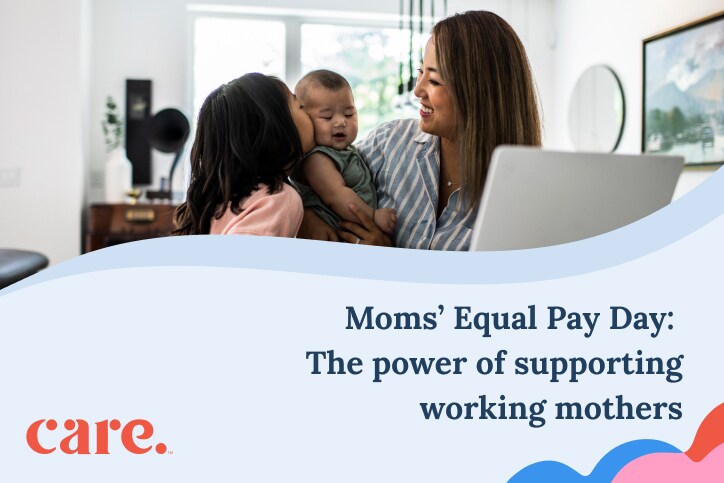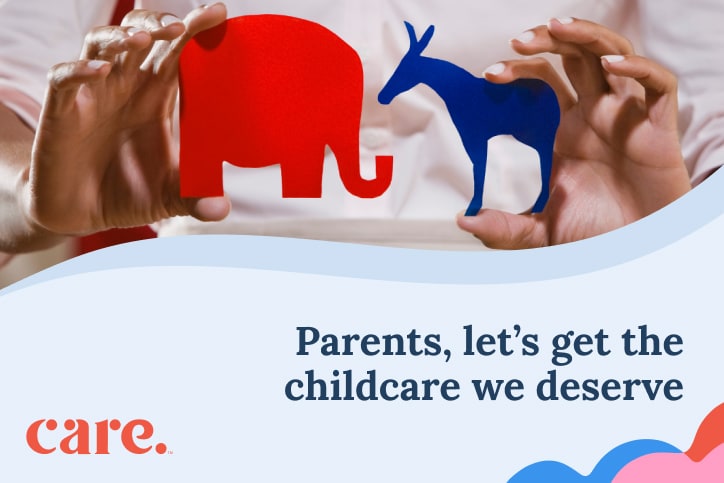Last month, I saw an article that took me aback as a working mother. It was about Mom’s Equal Pay Day which fell on August 15th this year. This made me feel compelled to speak up because although I am, in fact, a working mom, I had no idea Mom’s Equal Pay Day was a thing. That in and of itself is a problem. Why doesn’t this get more attention?
It was infuriating to learn that it took until mid-August for the average working mother to earn what the average working father earned in the previous year. There have been many headlines recently celebrating that women’s return to the workforce is at a record high, but none of them mention an important fact: moms only earn 62 cents to every dollar for working fathers.
More people need to be rattled by this. More people need to speak up. I’ll start. As a working mother of two young children who has personally navigated the intricacies of balancing my family and my career, I know all too well the challenges faced by working mothers. And I have some thoughts about how we create true equality for moms in the workplace.
The reality for working moms
The decision to have children is personal and complex for everyone and for a working woman there’s an entirely special set of considerations: Will I be stunted on my career path? Will my peers perceive me as less reliable or less available? Will taking maternity leave set me back? Will I even have access to maternity leave at all?
Regrettably, these fears are not irrational. New research discovered that the “motherhood penalty” impacts all mothers in America across industry, pay level, and level of education. Additionally, the study finds that in “female-breadwinner” families, higher-earning women experience a 60% drop from their pre-childbirth earnings relative to their male partners. In comparison, fathers seem to experience a “fatherhood premium” with an increase in pay when they have children. Not only do fathers ages 25 to 54 earn more than mothers the same age, they also earn more than men with no children at home.
Working women may also be concerned about having children due to the lack of parental leave in America, one of only two developed nations without a national paid leave program. In fact, about 80% of U.S. workers are left without paid time off after the birth of a child and even with the Family and Medical Leave Act, nearly half of workers are not guaranteed unpaid, job-protected leave.
It seems as if we are doing everything to thwart working moms despite their tremendous contribution to our economy. Much of the nation’s GDP growth over the last 50+ years has been driven by female labor force participation, which included moms. And during the pandemic, we saw very quickly what happened when working moms didn’t have access to childcare with millions forced to leave the workforce. We are at risk of repeating history as we are on the cusp of funding expiring that will put a potential 3.2 million children in danger of losing care. So what can be done to keep working moms working?
How to support working moms and the benefits of doing so
If we expect mothers to not only stay in the workforce, but also progress in their careers, employers must normalize motherhood at work through intuitive policies and benefits. Although there has been amazing progress recently through the Pregnant Workers Fairness Act, it is important to note that support for mothers shouldn’t end at birth, or even after the newborn stage, and instead should continue throughout the life of the child as it grows.
Flexibility in the workplace
As we’ve witnessed in recent years, flexibility in the workplace goes a long way in helping parents balance work, life, and family. In our The Modern Workplace Report, a stunning 77% of both men and women reported that remote work has leveled the playing field for career advancement across gender lines. And this isn’t only true for fully remote settings. Respondents said that hybrid work environments result in greater overall happiness, less stress, improved quality of life, more life balance, and more career fulfillment. By working at home, those surveyed said they’re able to spend more time with their kids (73%), spend more time with their partner (70%), and do household chores (71%).
For industries and companies that do not have the ability to make such a sweeping change through remote and hybrid settings, simple changes can also be made. For example, don’t schedule key meetings at the start or end of the day, when moms may be handling school drop off or pick up. Create a workplace culture where employees are comfortable coming to you if their child gets sick and needs to be picked up or let them head out early for their child’s ball game or recital. The reward is less distracted or disconnected employees and increased employee satisfaction, which pays off in countless ways.
Parental leave policies
Comprehensive parental leave policies provide mothers with time to connect with their newborn, recover from childbirth, and help combat postpartum depression and burnout. The benefits of parental leave also have strong, positive effects on children as well. Paid maternity leave is associated with a decrease in both the neonatal mortality rate and the infant mortality rate. Women who took paid maternity leave experienced a nearly 50% decrease in the likelihood of rehospitalization for their infants and a 51% decrease in the chance that they would be rehospitalized themselves.
Through initiatives like theSkimm’s #ShowUsYourLeave movement, parental leave is becoming further normalized and is in high demand as more companies try to support their employees as humans, not just workers. Care.com proudly offers a generous paid parental leave policy to our employees through 16 weeks of paid leave and a new parent bonus in order to ensure our working parents remain healthy and supported through such a pivotal time in their lives.
Child care benefits
Child care benefits can support mothers beyond the newborn stage as they return to work after maternity leave. Our enterprise arm, Care for Business, works with hundreds of employers across industries to provide care benefits to working families. Those benefits include a variety of services such as access to our platform and in-home or in-center back-up care, so parents don’t have to worry when their regular child care falls through.
Many people have questioned why employers should play any role in childcare and the answer is that it’s not just the right thing to do, it’s good for the bottom line. On an annual basis, $3 billion in revenue is lost because parents miss work when child care falls through. Plus, replacing an employee who leaves because of care issues is expensive: on average, it costs businesses 20% of an hourly employee’s salary and up to 150% of a manager’s salary. There’s even greater ROI.
With care benefits in place, our clients report:
- A 30% decrease in employee absences.
- 10 days of missed work saved.
- $1,698 saved in child care expenses per year, per family, on average.
- 59% of employees say family care benefits are among the most important benefits they value.
- 70% of employees indicate they are more likely to stay at their company if they offer Care benefits.
The numbers don’t lie. When employers invest in care, they are also investing in their employees and their business.
Let’s bring the date up next year
As a working mother in an executive position, I am proud of Care’s commitment to building best-in-class workplaces for working moms and dads alike, so they don’t have to choose between work and family. Our support for Care employees and our Care for Business clients is one piece of a larger puzzle, and the journey towards true equality for moms in the workplace will be a marathon, not a sprint. More employers need to join this critical mission of supporting parents and bridging the pay gap bit by bit. If they do, perhaps next year Mom’s Equal Pay Day will arrive much earlier.






